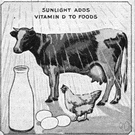cal·cif·er·ol
(kăl-sĭf′ə-rôl′, -rōl′)n.
Vitamin D, especially vitamin D2.
[calcifer(ous) + -ol.]
American Heritage® Dictionary of the English Language, Fifth Edition. Copyright © 2016 by Houghton Mifflin Harcourt Publishing Company. Published by Houghton Mifflin Harcourt Publishing Company. All rights reserved.
calciferol
(kælˈsɪfərɒl)n
(Biochemistry) a fat-soluble steroid, found esp in fish-liver oils, produced by the action of ultraviolet radiation on ergosterol. It increases the absorption of calcium from the intestine and is used in the treatment of rickets. Formula: C28H43OH. Also: vitamin D2
[C20: from calcif(erous + ergost)erol]
Collins English Dictionary – Complete and Unabridged, 12th Edition 2014 © HarperCollins Publishers 1991, 1994, 1998, 2000, 2003, 2006, 2007, 2009, 2011, 2014
cal•cif•er•ol
(kælˈsɪf əˌrɔl, -ˌrɒl)n.
a fat-soluble, crystalline, unsaturated alcohol, C28H43OH, occurring in milk, fish-liver oils, etc., produced by ultraviolet irradiation of ergosterol and used as a dietary supplement, as in fortified milk. Also called vitamin D2.
[1930–35; calcif (erous) + (ergost) erol]
Random House Kernerman Webster's College Dictionary, © 2010 K Dictionaries Ltd. Copyright 2005, 1997, 1991 by Random House, Inc. All rights reserved.
ThesaurusAntonymsRelated WordsSynonymsLegend:
| Noun | 1. |  calciferol - a fat-soluble vitamin that prevents rickets calciferol - a fat-soluble vitamin that prevents ricketsergosterol - a plant sterol that is converted into vitamin D by ultraviolet radiation fat-soluble vitamin - any vitamin that is soluble in fats |
Based on WordNet 3.0, Farlex clipart collection. © 2003-2012 Princeton University, Farlex Inc.